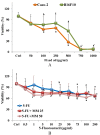Maltese mushroom (Cynomorium coccineum L.) as source of oil with potential anticancer activity
- PMID: 25629557
- PMCID: PMC4344564
- DOI: 10.3390/nu7020849
Maltese mushroom (Cynomorium coccineum L.) as source of oil with potential anticancer activity
Abstract
The present study aimed to examine the potential anticancer properties of fixed oil obtained from Maltese mushroom (Cynomorium coccineum L.), an edible, non-photosynthetic plant, used in traditional medicine of Mediterranean countries to treat various ailments and as an emergency food during the famine. We investigated the effect of the oil, obtained from dried stems by supercritical fractioned extraction with CO2, on B16F10 melanoma and colon cancer Caco-2 cell viability and lipid profile. The oil, rich in essential fatty acids (18:3n-3 and 18:2n-6), showed a significant growth inhibitory effect on melanoma and colon cancer cells. The incubation (24 h) with non-toxic oil concentrations (25 and 50 μg/mL) induced in both cancer cell lines a significant accumulation of the fatty acids 18:3n-3 and 18:2n-6 and an increase of the cellular levels of eicosapentaenoic acid (20:5n-3) with anticancer activity. Moreover, the oil exhibited the ability to potentiate the growth inhibitory effect of the antitumor drug 5-fluorouracil in Caco-2 cells and to influence the melanin content in B16F10 cells. The results qualify C. coccineum as a resource of oil, with potential benefits in cancer prevention, for nutraceutical and pharmaceutical applications.
Figures





Similar articles
-
Chemical composition and effect on intestinal Caco-2 cell viability and lipid profile of fixed oil from Cynomorium coccineum L.Food Chem Toxicol. 2012 Oct;50(10):3799-807. doi: 10.1016/j.fct.2012.07.003. Epub 2012 Jul 15. Food Chem Toxicol. 2012. PMID: 22809475
-
Astringent drugs for bleedings and diarrhoea: The history of Cynomorium coccineum (Maltese Mushroom).J Ethnopharmacol. 2020 Mar 1;249:112368. doi: 10.1016/j.jep.2019.112368. Epub 2019 Oct 31. J Ethnopharmacol. 2020. PMID: 31678417 Review.
-
Potential anti-tumor effects of Mugil cephalus processed roe extracts on colon cancer cells.Food Chem Toxicol. 2013 Oct;60:471-8. doi: 10.1016/j.fct.2013.08.009. Epub 2013 Aug 12. Food Chem Toxicol. 2013. PMID: 23948356
-
Extraction and separation of volatile and fixed oils from seeds of Myristica fragrans by supercritical CO₂: chemical composition and cytotoxic activity on Caco-2 cancer cells.J Food Sci. 2012 Apr;77(4):C448-53. doi: 10.1111/j.1750-3841.2012.02618.x. Epub 2012 Mar 19. J Food Sci. 2012. PMID: 22429024
-
The Modern Use of an Ancient Plant: Exploring the Antioxidant and Nutraceutical Potential of the Maltese Mushroom (Cynomorium Coccineum L.).Antioxidants (Basel). 2019 Aug 7;8(8):289. doi: 10.3390/antiox8080289. Antioxidants (Basel). 2019. PMID: 31394783 Free PMC article. Review.
Cited by
-
Identification and characterization of chemical components in the bioactive fractions of Cynomorium coccineum that possess anticancer activity.Int J Biol Sci. 2020 Jan 1;16(1):61-73. doi: 10.7150/ijbs.38475. eCollection 2020. Int J Biol Sci. 2020. PMID: 31892846 Free PMC article.
-
Optimization of Extract Method for Cynomorium songaricum Rupr. by Response Surface Methodology.J Anal Methods Chem. 2017;2017:6153802. doi: 10.1155/2017/6153802. Epub 2017 Dec 24. J Anal Methods Chem. 2017. PMID: 29435384 Free PMC article.
-
Mushroom oils: A review of their production, composition, and potential applications.Heliyon. 2024 May 22;10(11):e31594. doi: 10.1016/j.heliyon.2024.e31594. eCollection 2024 Jun 15. Heliyon. 2024. PMID: 38845934 Free PMC article. Review.
-
Antimicrobial, antioxidant and anti-tyrosinase properties of extracts of the Mediterranean parasitic plant Cytinus hypocistis.BMC Res Notes. 2015 Oct 13;8:562. doi: 10.1186/s13104-015-1546-5. BMC Res Notes. 2015. PMID: 26462912 Free PMC article.
-
Chemical composition and enzyme inhibition of Phytolacca dioica L. seeds extracts.J Enzyme Inhib Med Chem. 2019 Dec;34(1):519-527. doi: 10.1080/14756366.2018.1563077. J Enzyme Inhib Med Chem. 2019. PMID: 30688117 Free PMC article.
References
-
- IUCN. International Union for Conservation of Nature and Natural Resources. Centre for Mediterranean Cooperation . A Guide to Medicinal Plants in North Africa. IUCN Centre for Mediterranean Cooperation; Malaga, Spain: 2005. Cynomorium coccineum L. pp. 99–100.
-
- Dharmananda S. Cynomorium—Parasitic Plant Widely Used in Traditional Medicine. [(accessed on 8 January 2013)]. Available online: http://www.itmonline.org/arts/cynomorium.htm.
-
- Abd El-Rahman H.A., El-Badry A.A., Mahmoud O.M., Harraz F.A. The effect of the aqueous extract of Cynomorium coccineum on the epididymal sperm pattern of the rat. Phytother. Res. 1999;13:248–250. - PubMed
-
- Duke J.A., Duke P.-A.K., duCellier J.L. Dukeʼs Handbook of Medicinal Plants of the Bible. 1st ed. CRC Press; Boca Raton, FL, USA: 2008.
-
- Lebling R.W. The treasure of tarthuth. Saudi Aramco World. 2003;54:12–17.
MeSH terms
Substances
LinkOut - more resources
Full Text Sources
Other Literature Sources
Medical

